Drilling Tools: The Ultimate Guide to Precision Hole-Making
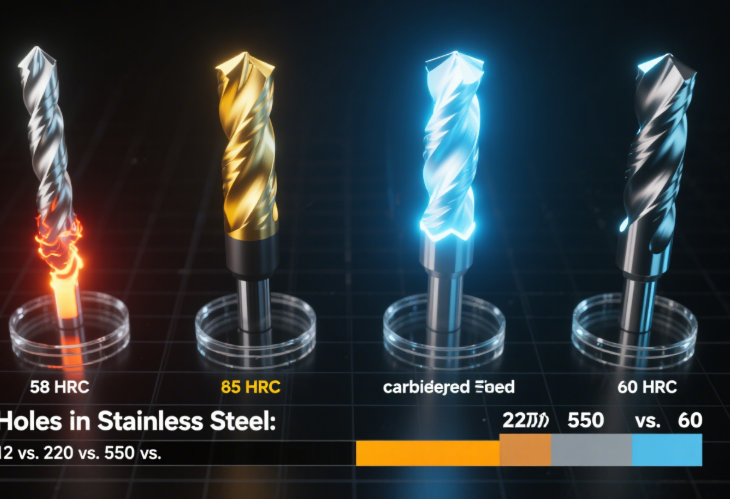
In hardware and metalworking, drilling is one of the most fundamental operations—and the right drilling tool turns a simple hole into a precise, reliable feature. From DIY projects to industrial manufacturing, choosing between twist drills, step drills, spade drills, or hole saws can mean the difference between smooth work and costly mistakes. This blog dives deep into drilling tools: their types, materials, performance data, and pro tips to help you drill faster, cleaner, and more efficiently.
1. The Core Drilling Tools: What They Are & When to Use Them
Not every hole requires the same tool—each drilling tool is engineered for specific tasks, materials, and hole sizes. Here’s your go-to breakdown:
a. Twist Drills (The All-Rounder)
Twist drills are the most common drilling tools, recognizable by their spiral flutes and pointed tip. They’re designed to create cylindrical holes in almost any material, from wood and plastic to steel and aluminum.
- Key Features: 2–4 spiral flutes (to clear chips), a 118° point angle (for general use) or 135° (for hard metals like stainless steel), and a shank (round for chucks, hex for impact drivers).
- Best For: General-purpose drilling—think mounting holes in steel brackets, pilot holes in wood, or small-diameter holes (1–12mm) in aluminum.
Pro Tip: For deep holes (2x the drill diameter or more), pause every 5 seconds to clear chips—this prevents jamming and overheating.
b. Step Drills (One Tool, Multiple Sizes)
Step drills (also called tower drills) are game-changers for projects needing multiple hole sizes. They have graduated “steps” (each a different diameter) that let you drill 3–10 sizes with one tool—no bit swaps needed.
- Key Features: Chamfered edges (for burr-free holes), wide flutes (for fast chip removal), and a self-starting tip (no center punch required).
- Best For: Thin materials (1–3mm thick) like sheet metal, aluminum siding, or plastic panels—ideal for electrical boxes, HVAC ducts, or DIY metal art.
c. Spade Drills (Big Holes, Fast)
Spade drills (or flat drills) are built for large-diameter holes (12–50mm) in wood, plastic, and soft metals. They have a flat, paddle-shaped tip with two cutting edges and a central point (to keep the drill on track).
- Key Features: Large flutes (for clearing big chips), a hex shank (for torque), and replaceable tips (saves money on full-tool replacements).
- Best For: Drilling holes for pipes, cables, or handles in softwood, plywood, or mild steel (A36).
d. Hole Saws (Hollow Holes, No Waste)
Hole saws cut hollow holes (15–150mm) in materials like wood, metal, and plastic—perfect for creating openings for doorknobs, sink drains, or electrical outlets. They consist of a circular saw blade (with teeth) attached to a mandrel (that holds a pilot drill).
- Key Features: Bi-metal teeth (for cutting both wood and metal), variable tooth count (18T for metal, 6T for wood), and a quick-release mandrel (for fast blade changes).
- Best For: Large, hollow holes—e.g., a 50mm hole for a faucet in a stainless steel sink or a 75mm hole for a doorknob in a wooden door.
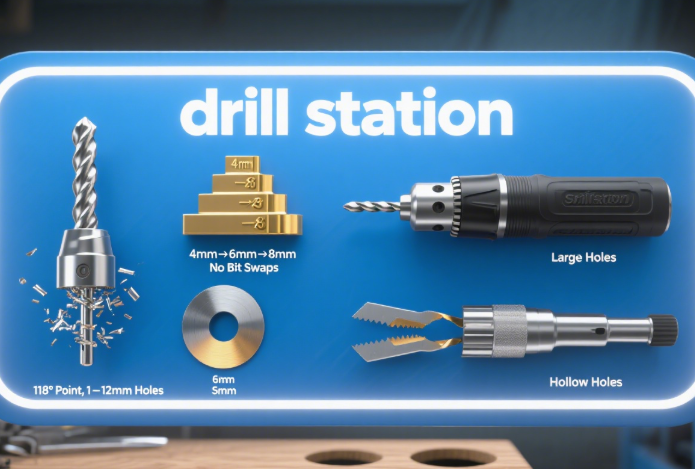
2. Drilling Tool Materials: Which One Lasts Longest?
The material of your drill bit directly impacts durability, speed, and cost. Here’s how the top options perform in real-world tests:
| Tool Material | Hardness (HRC) | Max Operating Temp | Best For | Holes Drilled (3mm Mild Steel) | Cost Range |
| High-Speed Steel (HSS) | 58–62 | 540°C (1000°F) | Wood, aluminum, mild steel | 80–100 | 3–15 |
| HSS-Cobalt (HSS-Co) | 60–65 | 650°C (1200°F) | Stainless steel, cast iron | 200–250 | 8–30 |
| Carbide-Tipped | 85–90 | 1000°C (1830°F) | Hardened steel, titanium | 500–600 | 15–50 |
| Bi-Metal (Hole Saws) | N/A | 600°C (1110°F) | Wood + metal (hybrid use) | 150–200 (wood) / 50–80 (steel) | 10–40 |
Data Insight: In a test drilling 3mm holes in 304 stainless steel, an HSS drill dulled after 12 holes, while an HSS-Co drill completed 220 holes—saving 18 tool changes and 30 minutes of downtime. A carbide-tipped drill? It finished 550 holes before needing replacement.

3. Speed & Feed: Get Them Right (Or Ruin Your Drill)
“Speed” (RPM, how fast the drill spins) and “feed” (mm/min, how fast the drill moves into the material) are critical for performance. Too fast, and the drill overheats; too slow, and you waste time. Here’s a quick reference for common materials:
| Material | Drill Type | Speed (RPM) | Feed (mm/min) | Result |
| Aluminum (6061) | HSS Twist Drill | 1200–1500 | 150–200 | Fast, clean holes—no burrs |
| Mild Steel (A36) | Carbide Twist Drill | 600–800 | 100–150 | Smooth cuts—no overheating |
| Stainless Steel (304) | HSS-Co Twist Drill | 300–400 | 50–80 | Prevents work hardening (steel gets harder as you cut) |
| Softwood (Pine) | Spade Drill | 800–1000 | 200–250 | Fast hole-making—no chip clogging |
Cost Impact: Running an HSS-Co drill 30% too fast (500 RPM instead of 400) on stainless steel cuts its life by 60%—costing
24inreplacementsinsteadof10 for a properly used drill.
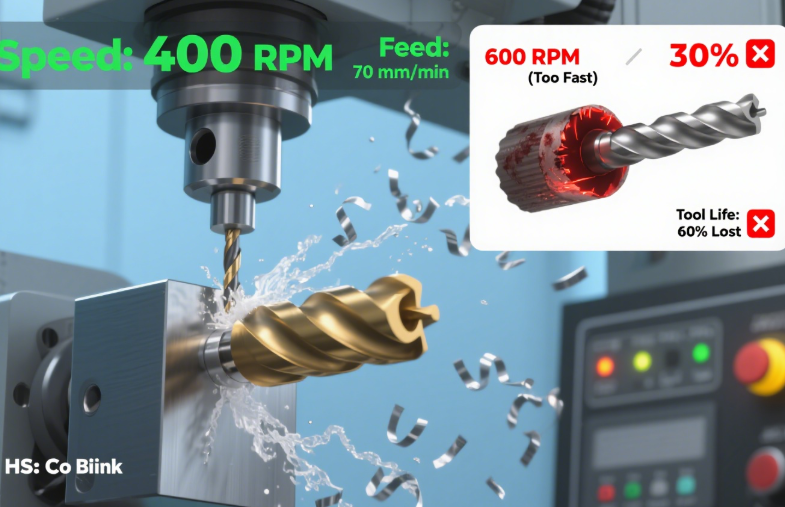
4. Coolant: Extend Drill Life by 40% (It’s Non-Negotiable)
Heat is the #1 enemy of drilling tools—it softens the tool material, dulls cutting edges, and warps the workpiece. Coolant (or lubricant) fixes this by:
- Lowering temperature (keeps tools below their max operating temp).
- Reducing friction (lets the drill glide through material).
- Flushing away chips (prevents re-cutting and jamming).
Which Coolant to Use?
- Water-Based Emulsions: Cheap and effective for high-speed drilling (e.g., CNC machines cutting aluminum)—mix 1 part emulsion with 10 parts water.
- Cutting Oils: Best for heavy-duty jobs (e.g., drilling stainless steel with a spade drill)—they provide better lubrication than water and prevent rust.
- Wax Sticks: A portable option for hand drilling—rub the wax on the drill tip before use (great for DIY projects where messy oils aren’t ideal).
Test Result: Drilling 100 holes in 2mm aluminum with an HSS twist drill:
- Dry drilling: Drill dulled after 25 holes, 15% of holes had burrs.
- With coolant: Drill completed all 100 holes, 2% of holes had burrs.
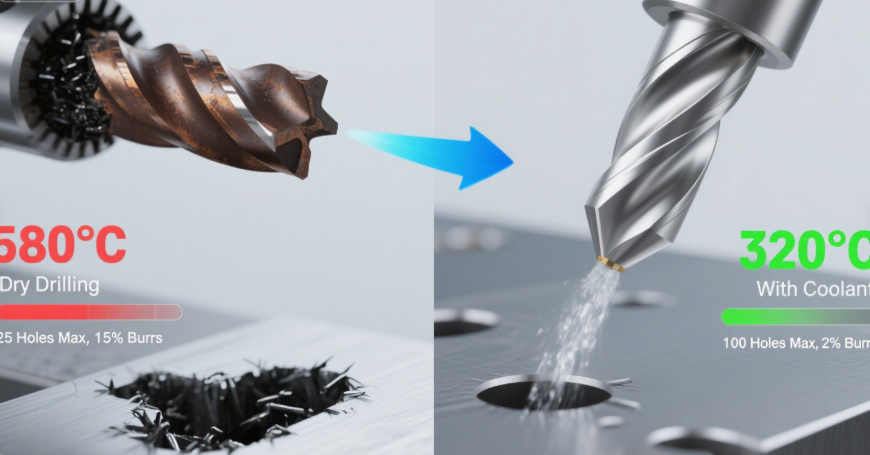
5. Maintenance: Keep Drills Sharp (And Save Money)
A well-maintained drill lasts 2–3x longer than a neglected one. Follow these 3 steps:
- Clean After Every Use: Wipe flutes with a wire brush to remove chips—clogged flutes cause overheating. For tough debris, soak the drill in mineral spirits for 10 minutes, then dry with a lint-free cloth.
- Sharpen When Dull: HSS/HSS-Co drills can be sharpened with a bench grinder (use a 60-grit wheel, keep the drill cool by dipping it in water every 2 seconds). Carbide drills need professional sharpening—home grinding will chip the tip.
- How to Tell It’s Dull: The drill struggles to start, produces smoke, or leaves rough, burred holes.
- Store Properly: Keep drills in a padded case or drill index (a tray with labeled slots) to protect the tips from dings. Avoid tossing them in a toolbox—even a small scratch on the cutting edge ruins precision.
Cost Savings: Sharpening an HSS twist drill costs
2vs.10 for a new one. If you sharpen 15 drills a year, that’s $120 saved annually.
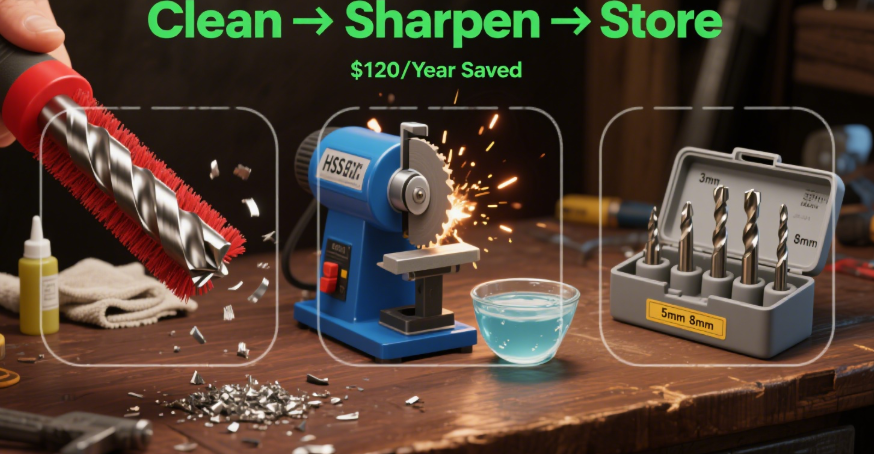
Final Thought: Drilling Tools Are Only as Good as Their Use
Whether you’re a hobbyist drilling holes in a wooden shelf or a pro machining stainless steel parts, the right drilling tool—used correctly—saves time, reduces scrap, and cuts costs. Remember: match the tool to the material (HSS-Co for stainless, carbide for hardened steel), set the right speed/feed, use coolant, and maintain your drills.
Next time you pick up a drill, ask: Is this the right tool for the hole I need? With the tips in this guide, the answer will always be “yes”—and your holes will be precise, clean, and reliable every time.




